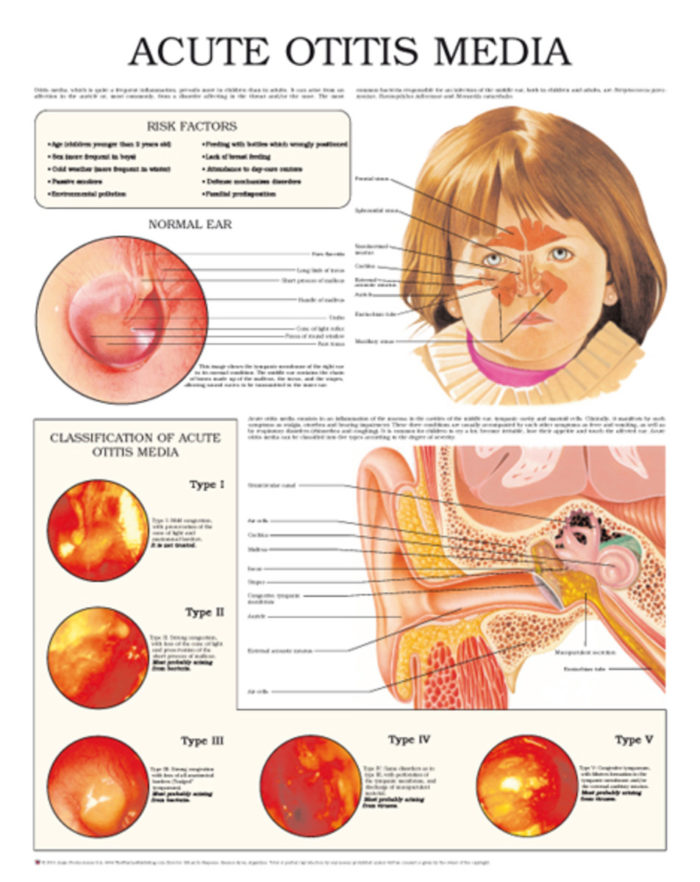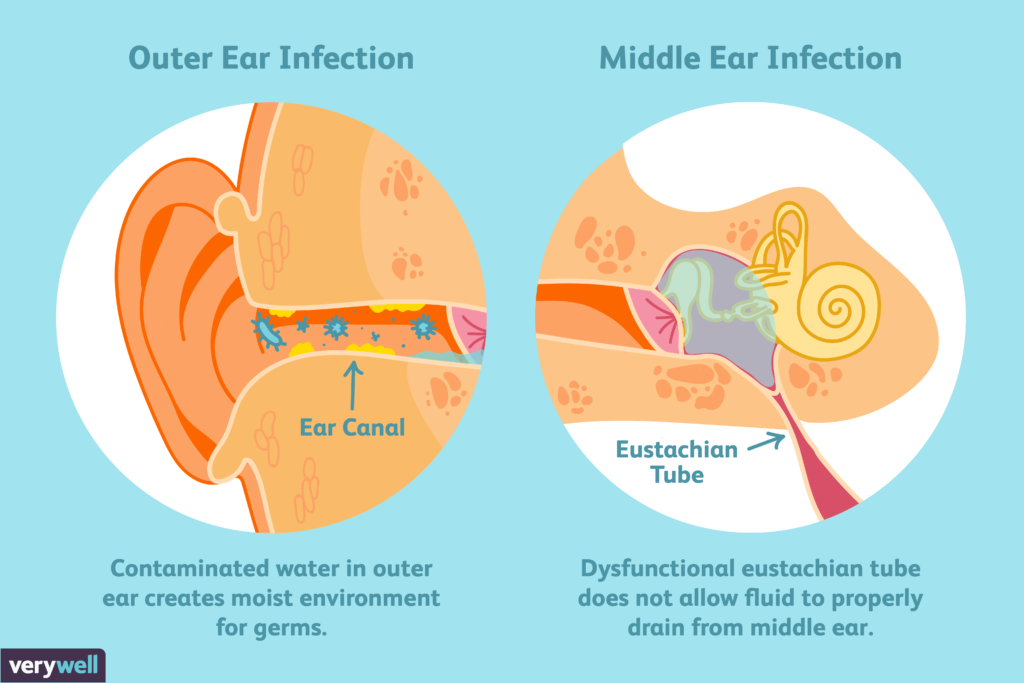In the bewildering realm of childhood ailments, ear infections hold a prominent position as they often provoke significant discomfort and agony. Among the various sorts of these afflictions, otitis media reigns supreme in children’s lives, afflicting their middle ears relentlessly. This insidious condition arises when fluid accumulates behind the eardrum due to inflammation or infection within those enigmatic Eustachian tubes that connect one’s middle ear to their throat’s rear end. Consequently, this buildup fosters an idyllic breeding ground for bacteria and viruses to flourish unfettered, culminating in a dreaded middle ear infection.

A plethora of factors conspire against our young ones by instigating such infections; upper respiratory tract infections (those wretched colds or flus), allergies, exposure to secondhand smoke lurking around every corner, and even altitude shifts experienced during aerial escapades. Regrettably, children are more susceptible than adults since their Eustachian tubes possess shorter lengths and maintain a horizontal orientation that invites bacteria-viral intruders with open arms into their vulnerable middle ears. To add insult to injury: youngsters’ immature immune systems struggle valiantly but may fail miserably at vanquishing these microscopic invaders.
In combating this chaotic ordeal faced by countless infants worldwide, it becomes crucial for parents and caregivers alike to recognize symptoms posthaste so that proper treatment can be sought without delay – time is indeed of the essence! Common indications include irritability akin to stormy weather; sleep filled with tossing-and-turning induced pain/discomfort originating from afflicted ears; feverish conditions (occasionally); persistent tugging on one’s own ears (particularly if aged under two years); hearing difficulties arising like uninvited guests plus balance-related issues emanating from pressure nestled deep within those beleaguered middle ears disrupting equilibrium functionally speaking – all signs beckoning further medical investigation potentially involving antibiotic prescriptions contingent upon severity/type as discerned by astute healthcare professionals.
Their ultimate goal? To avert complications while minimizing the risk of future recurrences through proactive measures such as inserting tympanostomy tubes (“ear tubes”) tailored to address chronic/recurring instances where conservative approaches fall woefully short. Furthermore, these prevention strategies remain steadfastly employed across all age demographics due to their universal applicability – focusing primarily on pediatric populations experiencing heightened infection rates compared to their adult counterparts. Thus, it necessitates increased vigilance from parents/guardians in ensuring timely intervention and implementing responsive care plans that cater to individual needs assessments accordingly.
Causes and Risk Factors for Otitis Media in Young Ones
A myriad of elements play a role in the heightened probability of young children succumbing to otitis media, or middle ear infections. The primary culprit lies in their eustachian tube anatomy; these tubes are shorter and more horizontal compared to those of adults, thus facilitating bacteria and viruses’ journey from nose and throat into the middle ear – an expressway towards infection. Coupled with the fact that a child’s immune system is still maturing, they become all the more vulnerable to ailments capable of inflaming and obstructing said eustachian tubes.

An assortment of situations can elevate a child’s susceptibility to ear infections. Tobacco smoke exposure or air pollution may undermine their respiratory well-being, leading to inflammation within nasal passages and eustachian tubes. Daycare center attendees are often exposed at higher rates to commonplace childhood illnesses resulting in symptoms akin to an ear infection: colds or upper respiratory infections abound. Bottle-feeding conducted horizontally also boosts infants’ likelihood for acquiring ear infections; milk might find its way into their eustachian tubes.
Grasping both otitis media symptoms and causes proves vital when pursuing treatment for children’s ear infections. Parents ought to recognize familiar indicators like fever, irritability, hearing difficulties (or responsiveness), ears being tugged due to pain behind the eardrum (ear pain), fluid draining from infected ears as well as sleep troubles – these could signify potential middle-ear infection necessitating medical intervention such as antibiotic therapy if healthcare professionals deem it requisite based on aspects like severity & duration during evaluation processes undertaken upon consultation visits scheduled promptly after detecting any concerning changes in your child’s overall welfare particularly if they belong under high-risk categories expounded earlier within this article section dedicated towards offering invaluable insights relating specifically toward understanding diverse facets surrounding pediatric cases involving recurrent episodes tied directly with underlying conditions predisposing particular individuals becoming more susceptible than others including adults who contract infections despite possessing superiorly developed anatomical structures ensuring the finest functionality across all auditory system components such as eustachian tubes in charge of maintaining an equilibrium between air pressure levels both inside & outside the middle ear cavity situated directly behind the tympanic membrane, colloquially known simply as eardrum.
Recognizing Symptoms of Middle Ear Infections in Kids
In the realm of childhood maladies, ear infections emerge with notable frequency, especially in those tender souls under six years of age. Otitis media with effusion (OME) stands as a common exemplar, characterized by fluid’s unwelcome accumulation within the middle ear – sans pain or fever. Often emerging in the wake of respiratory infections, this condition may linger for weeks even after its precursor has dissipated. Thus arises the paramount importance for caregivers to identify OME and other auditory afflictions so that timely treatment may be sought.
The telltale signs that bespeak an afflicted child encompass such manifestations as persistent ear-tugging, dulled hearing or responsiveness to sound, irascibility, loss of equilibrium, feverishness, discharge from the auricular canal and disturbed slumber. Infections oftentimes accompany colds or sinus issues due to inflammation obstructing Eustachian tubes connecting middle ear and throat’s posterior reaches. Once blocked off thusly, fluid entrapment ensues within these chambers – a breeding ground fertile for bacterial invasion and subsequent infection.
To ascertain whether one’s offspring suffer from such otic ailments or perhaps external troubles like swimmer’s ear (otitis externa), it is imperative that parents consult pediatric experts who shall scrutinize patients meticulously using specialized instruments such as pneumatic otoscopy or tympanometry where needed. These diagnostic evaluations serve to assess airflow through Eustachian conduits while also probing any internal buildup therein present.
Upon collating examination findings alongside parental reporting on symptoms observed at home amongst family members/caregivers/guardians/etc., healthcare professionals shall proffer appropriate treatments which could include antibiotics if warranted; moreover suggestions might be made regarding preventative measures addressing underlying factors contributing to future occurrences – allergies upper-respiratory tract illnesses notwithstanding among others ensuring overall health wellbeing young ones remains top priority throughout recovery process beyond\n
Consulting a Pediatrician: When Your Child Needs Medical Attention
In the realm of juvenile auricular maladies, pediatricians hold an indispensable key to discerning and directing treatment for ear infections. Given the heightened vulnerability of younglings compared to their adult counterparts, it falls upon caregivers to be vigilant in observing their offspring’s well-being and seeking expert counsel when warranted. The specter of ear infections looms larger if a nascent respiratory affliction has recently plagued the child or exposure to elements conducive for bacterial or viral proliferation has occurred – particularly within those hidden recesses at the rear of nasal passages and pharynx where such invaders may embark upon odysseys towards middle-ear territories.
As your progeny undergoes scrutiny, a pediatrician will likely evaluate overt manifestations indicative of an ear infection; these may encompass erythema, edematous tissue, exudate trailing from behind auricles, discomfort, or pyrexia. They might also employ an otoscope – a device purpose-built for peering into auditory realms – inspecting any inflammation or ensnared fluids therein. Should your child suffer recurring bouts of medial-auricle inflammations wherein persistent liquid lingers despite antibiotic intervention, they could find themselves prime candidates for tympanostomy tubes (colloquially dubbed “ear tubes”) which serve as conduits expelling surplus fluid from beyond tympanic membranes while mitigating undue pressure on inner-ear architecture and forestalling complications.
Addressing existing ear infections with alacrity is crucial; equally vital is adopting prophylactic strategies under healthcare professionals’ tutelage to curtail prospects for future incidents. Your pediatrician shall doubtless proffer bespoke suggestions hinged on individual circumstances — potential advice might entail adherence to stringent hygienic protocols like handwashing coupled with circumventing allergens or irritants that populate domestic surroundings capable of fostering microbial proliferation within pharyngeal depths which ultimately precipitate conditions impacting the fragile mechanisms governing audition and equilibrium systems.
Antibiotics and Other Treatments for Childhood Ear Infections
Antibiotics frequently emerge as the premier remedy for children besieged by ear infections, specifically those under half a year or regularly afflicted. Essential to recall, one must note that quintuple out of sextuple juveniles will face no less than a singular ear infection by their tertiary anniversary – establishing it among the most rampant ailments of youth. Albeit antibiotics may vanquish bacterial onslaughts effectively, they falter against viral foes. In certain circumstances, pediatric virtuosos might advocate “vigilant observation,” allowing time for potential spontaneous amelioration before resorting to antibiotic prescription.
Beyond antibiotics lie alternative treatments for juvenile auricular maladies: pain mitigators and decongestants combat pressure in the median ear resulting from fluid accumulation. These medications alleviate discomfort whilst bolstering symptomatic improvement as the body repels infection. Moreover, lifestyle adjustments and prophylactic strategies lower otic infection susceptibility; limiting exposure to environmental tobacco smoke and ensuring hygienic practices like hand cleansing forestall affliction.
Amidst severe or frequent manifestations of otitis media (inflammatory middle-ear turmoil), medical practitioners may propose introducing minute cylinders called tympanostomy tubes into eardrums via minor surgical incision. This maneuver permits airflow into your progeny’s median ears through Eustachian passages – equalizing eardrum pressure bilaterally while thwarting fluid buildup – thus diminishing probability of recurrent or chronic complications such as auditory impairment! The determination hinges upon factors encompassing age range alongside frequency/type intensity levels previously encountered; nevertheless, ultimate objectives remain unwavering: alleviating distress caused due aforementioned complexities while enhancing overall quality of life throughout recuperation process thereafter moving forward towards prevention future instances alike altogether concurrently simultaneously too indeed nonetheless always forevermore everlastingly perpetually unendingly incessantly unceasingly ceaselessly without end eternally everlasting never-ending interminably on and off.
The Role of Ear Tubes in Managing Recurrent Infections
Ah, ear tubes – or tympanostomy tubes, as they’re formally known – those minuscule contraptions that nestle within the eardrum to bring relief from the trials and tribulations of recurrent middle ear infections. By fashioning a tiny aperture in said eardrum, these diminutive devices facilitate fluid drainage from the middle ear’s inner sanctum, fending off numerous potential infections. Moreover, they lend a helping hand in ventilating the middle ear’s recesses; thus reducing pressure accumulation and enhancing auditory perception. It is not uncommon for children who’ve weathered multiple bouts of otitis media or endured persistent fluid presence in their ears to be prime candidates for this procedure.
Now you might wonder why children seem more susceptible to these pesky ear infections? The answer lies within their Eustachian tube anatomy! This vital conduit links the middle ear with its neighbor – the back of one’s throat – ensuring equilibrium between both realms’ pressures. Alas! In younglings, this tube tends to be shorter and more horizontal than its adult counterpart, providing an easy passage for bacteria or viruses voyaging from nose and throat into unsuspecting ears through this very same Eustachian pathway. Such unwelcome visitors may incite inflammation and infection amidst various structures (e.g., ossicles), leading to sensations of fullness along with other symptoms like pain or fever.
But fear not! Not all cases necessitate intervention via invasive procedures such as tympanostomy tube placements; however, if your child’s pediatrician deems their recurring otitis media chronic or detects significant hearing loss due to long-term fluid retention despite medical treatment attempts – well then! Your little one might just qualify as an apt candidate for receiving these specialized implants crafted specifically at mitigating issues among affected patients by offering suitable drainage channels whilst simultaneously restoring normal auditory functionality wherever feasible during post-surgical recovery periods. The aim? To ensure minimal disruption to daily life activities whilst navigating the tumultuous journey of illness itself, without placing undue stress on either the child or their family members – fostering optimal outcomes in terms of physical health and emotional well-being alike as they forge ahead into a future free from otitis media’s unwelcome grasp.
Preventive Measures to Reduce the Occurrence of Ear Infections
A most efficacious approach to averting ear maladies in little ones is ensuring the utter vanishment of current infections. Accomplishing this entails adhering to a prescribed course of action and attending pediatrician consultations post-symptom abatement. A prevalent infection known as otitis media arises when fluid becomes entrapped behind eardrums due to inflammation or obstruction in the slender passageway linking the auditory organ to the throat’s rear (the eustachian tubes). Ensuring an infection ceases not only assuages discomfort but fortifies against future bacterial or viral invasions.
Exposure to secondhand smoke, mingling with large clusters of peers at childcare establishments, or experiencing allergies render children more susceptible to ear afflictions. Approximately 75% will endure acute otitis media before reaching their third year. The middle ear houses three miniature bones that relay sound vibrations from eardrums; thus, safeguarding these fragile structures from repetitive infections is vital for preserving sensory cells responsible for hearing and balance functions. By restricting cigarette smoke exposure, promoting proper hand hygiene practices at home and daycare facilities, and conversing about allergy management choices with healthcare professionals, parents can mitigate risk factors.
In addition to environmental influences, some medical measures might ward off recurring instances. For example: particular inoculations may directly or indirectly result in fewer ear infections among youngsters—the pneumococcal conjugate vaccine (PCV) defends against Streptococcus pneumoniae – a principal perpetrator underlying bacterial cases—while influenza vaccinations shield from viral causes during flu season months each year since complications such as untreated upper respiratory tract illnesses could eventually culminate into developing acute otitis media if unchecked over time! Moreover, should a child suffer recurrent ear infections, their pediatrician might propose inserting minuscule tubes into eardrums allowing fluid drainage through eustachian tubes more efficiently—an intervention called tympanostomy—significantly alleviating pain and hearing loss linked to chronic or repeated cases while enabling easier administration of medicines for treating ear infections. By proactively addressing risk factors and seeking suitable medical interventions, parents can bolster their child’s recuperation whilst minimizing the probability of subsequent complications related to ear infections.
Supporting Your Child’s Recovery and Preventing Future Infections
In the realm of childhood ailments, ear infections do tend to bewilder and beleaguer little ones, particularly those in the delicate age bracket of 6 months to 2 years. While seeking counsel and treatment from medical professionals remains indispensable, parents too can wield significant influence over their child’s recuperation process as well as stave off future incidents. A critical aspect requiring keen parental scrutiny is the child’s surroundings since certain elements may escalate the likelihood of a middle ear infection brewing.
For example, youngsters exposed to tobacco fumes or mingling with large assemblies of peers at daycare facilities are more susceptible to contracting pesky ear infections. As such, safeguarding a pristine and smokeless home environment emerges as an essential measure for mitigating these risks. Moreover, mothers nursing infants under six months might impart some degree of immunity against ear infections through antibodies transmitted via breastmilk. Ensuring your little one receives vaccinations tailored to their age could also thwart certain viruses that potentially provoke an infection afflicting the vicinity of the ear.
Regarding treatment strategies for combating these troublesome ear infiltrations, pediatricians often advocate adopting a “watchful waiting” stance specifically for milder cases – predominantly among children aged two and above – wherein they meticulously track symptoms without hastily resorting to antibiotic prescriptions. This measured approach allows physicians ample scope in determining if spontaneous recovery occurs whilst averting potential side effects linked with antibiotic consumption. In instances where severity prevails or fluid stubbornly lingers within the middle ear sans natural resolution, healthcare practitioners may propose implanting diminutive tubes (termed tympanostomy tubes) into your offspring’s eardrums; this intervention forms part of comprehensive management endeavors designed to alleviate discomfort whilst warding off additional complications arising from these tenacious issues plaguing young patients today\n

